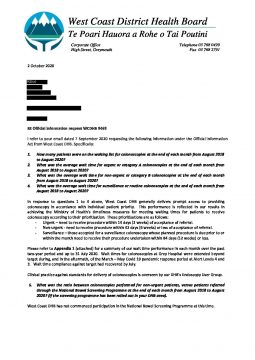RE Official information request WCDHB 9469
I refer to your email dated 7 September 2020 requesting the following information under the Official Information Act from West Coast DHB. Specifically:
1. How many patients were on the waiting list for colonoscopies at the end of each month from August 2018 to August 2020?
2. What was the average wait time for urgent or category A colonoscopies at the end of each month from August 2018 to August 2020?
3. What was the average wait time for non-urgent or category B colonoscopies at the end of each month from August 2018 to August 2020?
4. What was the average wait time for surveillance or routine colonoscopies at the end of each month from August 2018 to August 2020?
5. What was the ratio between colonoscopies performed for non-urgent patients, versus patients referred through the National Bowel Screening Programme at the end of each month from August 2018 to August 2020? (If the screening programme has been rolled out in your DHB area).
6. How many of your patients have recovered from colorectal cancer, versus those that died from the
disease between August 2019 and August 2020?
7. How many colonoscopies lead to a confirmed diagnosis of colorectal cancer each month from August 2018
to August 2020?
8. How many categories does your DHB divide your waiting list into? What are the criteria for each category?
9. How many people are presently on the colonoscopy waiting list for each of these categories?
10. How long is the average waiting time for each category?

